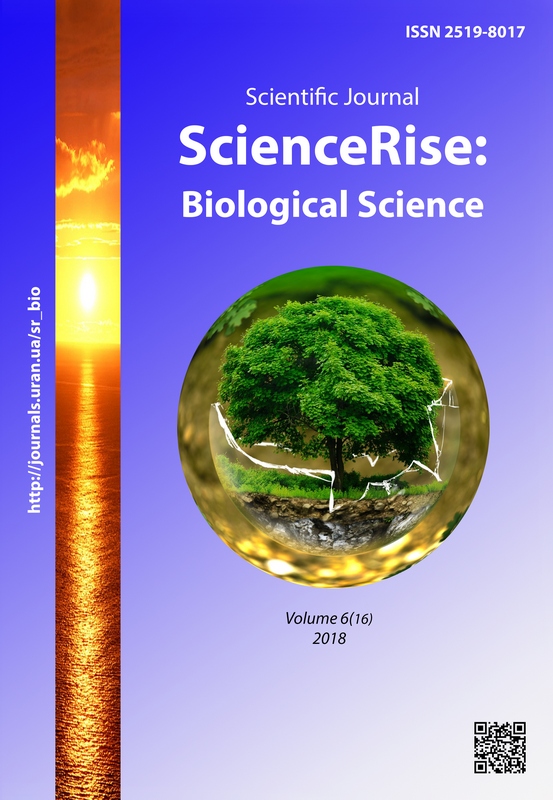Peculiarities of the component composition of ether oils of some representatives of Lamiaceae Lindl family in the conditions of forest-steppe of Ukraine and estimation of their biological activity
DOI:
https://doi.org/10.15587/2519-8025.2018.152968Keywords:
ether oil, pinecamferol, citral, thymol, biological activity, test-objects.Abstract
The purpose of the research is to study the biochemical composition, physical-and-chemical peculiarities of ether oils of dragonhead, hyssop, monarda and to determine their biological activity.
Materials and methods. Vegetative raw materials of dragonhead, hyssop, monarda were taken during the flowering period. The component composition of ether oils was studied at a gas chromatograph “Crystal 2000” with a flame-ionization detector. Components of ether oils were identified by the time of substance keeping of the standards of Fluka, Merck, Sigma companies. The allelopathic activity of ether oils, citral, thymol, pinecamferol was studied by the bio-tests method.
Results. The component composition of ether oils of scarlet monarda (Monarda didyma L), Moldavian dragonhead (Dracocephalum moldavicum L.), hyssop (Hyssopus officinalis L.) as valuable aromatic plants of polyfunctional value was studied and their physical-and-chemical parameters were determined. The main component of ether oil of hyssop plant was pinecamferol (84.68 %). The following compounds of terpenic nature as citral (49.9 %), geranilacetal (43.9 %) are found in ether oil of Moldavian dragonhead. Terpenic compounds of ether oils of scarlet monarda were represented by aromatic alcohols of thymol - 41,56 %. Growth processes of spring barley seedlings were slowed down while using oils synthesized from the vegetative material of all studied varieties at a concentration of 0.1 mcl (by 8.4-86.0 %), besides that hyssop oil had the least inhibitory effect. Concentrations of 0.1-1.0 mcl (92.74-98.85 %) especially in the variants with Moldavian dragonhead oil had the maximum impact on the development of garden-cress.
Conclusions. The connection of biological activity with the component composition of ether oils of studied representatives and their chemically pure basic components was analyzed. The high biological activity of the studied substances, which may be a regulator of the structure and functions of individual components of the ecosystem under natural conditions, was proved. The received results indicate the prospect for further study of the peculiarities of ether oils of three varieties of studied plants of Lamiaceae Lindl family - Hyssopus officinalis L., Monarda didyma L., Dracocephalum moldavicum L., where aromatic substances dominateReferences
- Gryummer, G. (1957). Vzaimnoe vliyanie vysshikh rasteniy. Allelopatiya. Moscow: Izdatel'stvo inostr. l-ry, 261.
- Rashidi, S., Eikani, M. H., Ardjmand, M. (2018). Extraction of Hyssopus officinalis L. essential oil using instant controlled pressure drop process. Journal of Chromatography A, 1579, 9–19. doi: http://doi.org/10.1016/j.chroma.2018.10.020
- Bobkova, I. A., Varlakhova, L. V., Mankovska, M. M. (2010). Farmakohnoziia. Kyiv: Medytsyna, 47–53.
- Bokov, D. O., Morokhyna, S. L., Luferov, A. N. (2013). Lekarstvennie rastenyia semeistva yasnotkovikh (Lamiaceae Lindl.) v botanycheskom sadu pervoho moskovskoho Hosudarstvennoho medytsynskoho unyversyteta imeni Y. M. Sechenova. Likarske roslynnytstvo: vid dosvidu mynuloho do novitnikh tekhnolohii. Poltava, 29–34.
- Ricci, D., Epifano, F., Fraternale, D. (2017). The Essential Oil of Monarda didyma L. (Lamiaceae) Exerts Phytotoxic Activity in Vitro against Various Weed Seed. Molecules, 22 (2), 222. doi: http://doi.org/10.3390/molecules22020222
- Hnatiuk, N. O. (2018). Alelopatychni vlastyvosti aromatychnykh roslyn vydiv Monarda didyma L., Dracocephalum moldavicum L., Hyssopus officinalis L. Uman: VPTs «Vizavi», 186.
- Grodzinskiy, A. M. (1991). Allelopatiya rasteniy i pochvoutomlenie. Kyiv: Nauk. dumka, 432.
- Derzhavna Farmakopeia Ukrainy (2001). Derzhavne pidpryiemstvo «Naukovo-ekspertnyi farmakopeinyi tsentr». Kharkiv: RIREH, 531.
- Hnatiuk, N. O. (2014). Alelopatychna aktyvnist roslynnykh reshtok vydiv Dracocephalum moldavicum L., Hyssopus officinalis L., Monarda didyma L. Naukovyi visnyk NLTU Ukrainy, 24.4, 46–50
- Yurchak, L. D. (1999). Kultura chornobryvtsiv v umovakh Lisostepu Ukrainy. Introduktsiia roslyn, 1, 49–54.
Downloads
Published
How to Cite
Issue
Section
License
Copyright (c) 2018 Gnatiuk Nataliia, Nataliia Dushechkina

This work is licensed under a Creative Commons Attribution 4.0 International License.
Our journal abides by the Creative Commons CC BY copyright rights and permissions for open access journals.
Authors, who are published in this journal, agree to the following conditions:
1. The authors reserve the right to authorship of the work and pass the first publication right of this work to the journal under the terms of a Creative Commons CC BY, which allows others to freely distribute the published research with the obligatory reference to the authors of the original work and the first publication of the work in this journal.
2. The authors have the right to conclude separate supplement agreements that relate to non-exclusive work distribution in the form in which it has been published by the journal (for example, to upload the work to the online storage of the journal or publish it as part of a monograph), provided that the reference to the first publication of the work in this journal is included.









